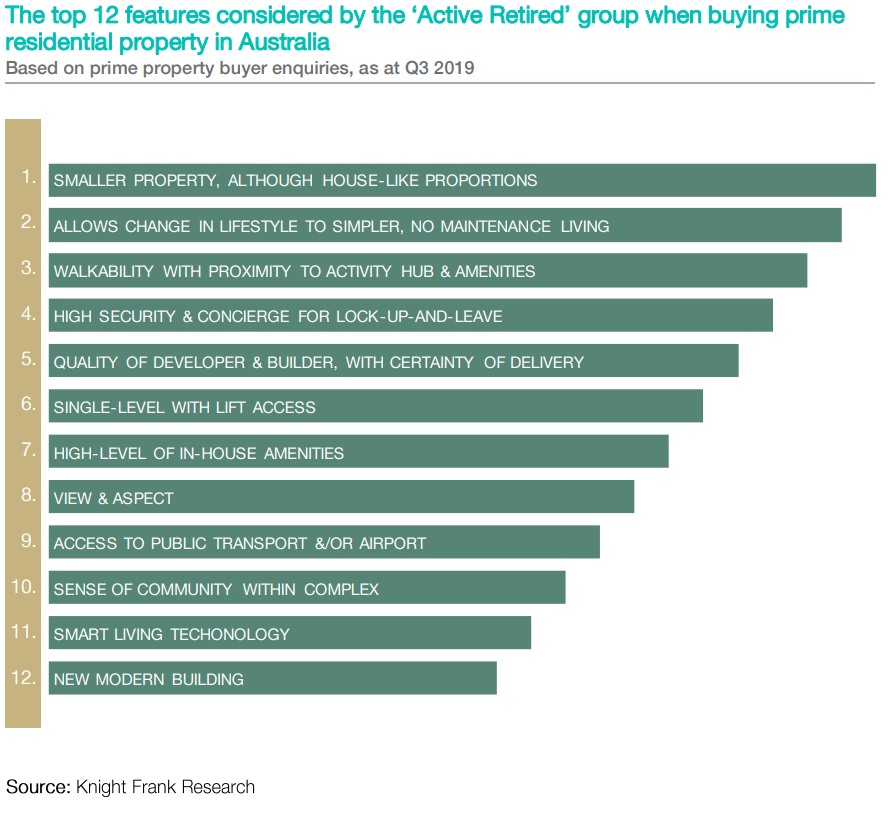The changing lifestyles amongst retirees are paving the way for a new trend in the prime housing market dubbed "rightsizing", according to the latest report from Knight Frank.
Downsizers, who typically want to escape the hustle and bustle of the urban setting, are now seeking easily maintainable prime properties close to city-centre locations.
"With this new active retiree lifestyle, they seek simplicity, and to feel the vibe from living close to the action. Downsizing the living areas is not part of this movement, but their new home request is to be the right size for them, with amenities to match their lifestyle," said Michelle Ciesielski, head of residential research at Knight Frank.
A smaller property with house-like proportions is one of the top 12 features being considered by active retirees when buying a prime residential home. They also tend to seek a minimum of three-bedroom configuration in prime suburbs. The graph below shows the other top must-have features retirees look for in a home:

Ciesielski said the rightsizing trend also appeals to other demographics, especially amongst entrepreneurs and growing families. As the demand for these medium-density homes increases, prices are expected to increase by as much as 10% this year.
Of all housing markets in Australia, the Gold Coast recorded the highest proportion of three-bedroom homes at 70%, followed by Brisbane at 61%.
"Both city pipelines show a further increase in the portion of total dwellings being built by the end of 2022 to 81% and 87% respectively," Ciesielski said.
The share of three-bedroom medium-density dwelling is expected to increase in Melbourne and Perth. On the other hand, the slice of the same housing in Sydney is projected to decline from 50% to 44%. Ciesielski said this could put upward pressure on prices.
"This shortfall will impact prices given the proximity to activity hubs and amenities ranks third most important for those looking to downsize and these regions are best suited to this lifestyle," Ciesielski said.
According to the figures released by the Australian Bureau of Statistics (ABS) last month, there is a lack of approvals for medium-density housing options like townhomes and duplexes across the country.
The tables below show the expected proportion of medium-density homes in selected prime suburb regions:
Share of 3-Bed Medium Density Homes (%) |
||
PRIME SUBURB REGIONS |
2017-2019 |
2020-2022 |
SYDNEY |
||
|
0 |
0 |
|
40 |
29 |
|
31 |
30 |
|
63 |
22 |
|
66 |
43 |
|
47 |
81 |
|
56 |
92 |
|
Total |
50 |
44 |
MELBOURNE |
||
|
27 |
0 |
|
18 |
0 |
|
67 |
42 |
|
39 |
38 |
|
46 |
49 |
|
47 |
63 |
|
Total |
43 |
52 |
BRISBANE |
||
|
50 |
86 |
|
77 |
78 |
|
71 |
95 |
|
56 |
88 |
|
58 |
83 |
|
Total |
61 |
87 |
PERTH |
||
|
0 |
0 |
|
30 |
30 |
|
24 |
59 |
|
33 |
23 |
|
Total |
27 |
50 |
GOLD COAST |
||